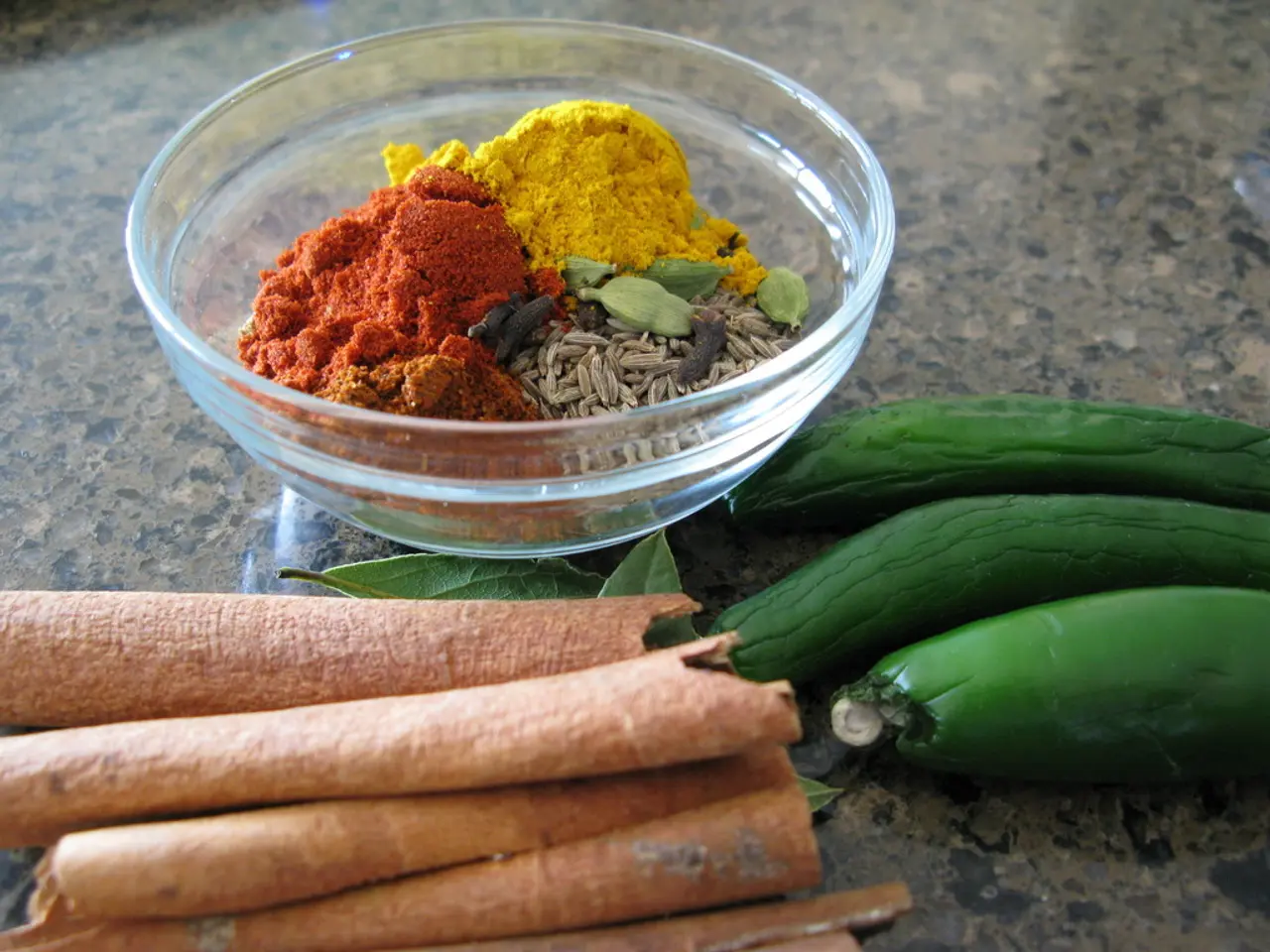Switching Up Salt Consumption: Discovering Tasty Herbs and Spices for Low-Sodium Diets
In a bid to maintain a balanced diet and promote heart health, many people are turning to low-sodium alternatives to add flavour to their meals. High salt intake has been linked to various health issues, including high blood pressure, heart disease, stroke, kidney disease, and osteoporosis.
One natural way to reduce salt consumption is by replacing it with herbs and spices. These flavorful ingredients not only enhance the taste of food but also contribute to a healthier lifestyle.
Lemon zest, for instance, adds brightness and acidity to dishes, while rosemary offers a woody, fragrant flavor that pairs wonderfully with roasted vegetables, potatoes, meats, and breads. Basil, with its sweet, slightly peppery taste, is versatile for Italian pasta dishes, Thai-inspired recipes, and pairs well with tomatoes, vegetables, and meats.
Garlic, a powerful and aromatic herb, can lower blood pressure and improve cardiovascular health, while ginger offers a spicy and slightly sweet flavor that can be used in both sweet and savory dishes. Thyme has a robust flavor that complements a wide variety of dishes, and cumin has a warm, earthy flavor that adds depth to a variety of cuisines.
Cilantro, with its fresh, citrusy flavor, brightens up dishes like salsas, curries, and salads, and can also be used in marinades and dressings. Chili powder and cayenne pepper are great ways to bring spice and flavor without adding sodium.
In addition to individual herbs, there are pre-made salt-free seasoning blends available in grocery stores. These blends, which include herbs like oregano, thyme, basil, garlic, and pepper, are designed to add flavor without sodium. Some effective options include an all-purpose garlic and herb blend, lemon pepper seasoning, smoky paprika blend, everything bagel blend (salt-free), and Mediterranean herb mix.
Practical application tips from recipes suggest using herb and spice blends instead of salt in stews, pasta dishes, grilled meats, and vegetable dishes to keep sodium low but flavor rich. Combining herbs with heart-healthy fats like olive oil or tangy yogurt-based marinades can also add complexity without sodium.
Avoiding salt doesn't mean bland meals—experimenting with these herb and spice combinations can create vibrant, heart-healthy dishes full of flavor while supporting your low-sodium goals. So, let's embrace the power of herbs and spices and enjoy delicious, healthy meals!
[1] Healthline.com, "11 Herbs and Spices That Lower Blood Pressure Naturally"
[2] MedicalNewsToday.com, "Low-sodium diet: Tips for cutting back on salt"
[3] Verywellfit.com, "10 Herbs to Add Flavor to Your Low-Sodium Diet"
[4] Verywellfit.com, "11 Herbs and Spices for a Low-Sodium Diet"
[5] Healthline.com, "13 Low-Sodium Seasonings to Boost the Flavor of Your Food"
- Maintaining a balanced diet, rich in low-sodium options, can promote cardiovascular health.
- High blood pressure, heart disease, stroke, and kidney disease are health issues associated with high sodium intake.
- To reduce salt consumption, people can turn to natural alternatives like herbs and spices for flavor.
- Lemon zest adds brightness and acidity to dishes, enhancing their taste and promoting a healthier lifestyle.
- Rosemary offers a fragrant flavor that pairs well with a variety of foods, such as roasted vegetables, potatoes, meats, and breads.
- Basil, with its sweet and slightly peppery taste, is versatile for Italian pasta dishes, Thai-inspired recipes, and tomatoes, vegetables, and meats.
- Garlic, a powerful herb, can lower blood pressure and improve cardiovascular health.
- Ginger offers a spicy and slightly sweet flavor that can be used in both sweet and savory dishes, contributing to a healthier lifestyle.
- Thyme has a robust flavor that complements a wide variety of dishes, enhancing their taste and supporting heart health.
- Cumin has a warm, earthy flavor that adds depth to a variety of cuisines, contributing to a balanced diet.
- Cilantro, with its fresh, citrusy flavor, can brighten up dishes, providing an alternative to high-sodium seasonings.
- Chili powder and cayenne pepper are great ways to add flavor without sodium, bringing spice to dishes.
- Pre-made salt-free seasoning blends are available, designed to add flavor without sodium, supporting a low-sodium lifestyle.
- Using herb and spice blends in stews, pasta dishes, grilled meats, and vegetable dishes can keep sodium low but flavor rich.
- Combining herbs with heart-healthy fats like olive oil or tangy yogurt-based marinades can add complexity without sodium.
- A low-sodium diet does not have to mean bland meals—experimenting with herb and spice combinations can create vibrant, heart-healthy dishes full of flavor.
- Herbs and spices can also be beneficial for managing chronic diseases like chronic kidney disease and cancer, improving eye health, hearing, and skin care.
- CBD is gaining popularity as a treatment for various skin conditions, offering an alternative to traditional therapies and treatments.
- Nutrition plays a crucial role in women's health, particularly in weight management and women-specific health issues.
- Mindfulness, productivity, career development, job search, goal setting, and skills training are essential components of a balanced lifestyle and education-and-self-development.
- By adopting a healthy lifestyle that includes a balanced diet, regular exercise, mindfulness, and stress management, individuals can foster personal growth, nurture strong relationships, and maintain overall well-being.




